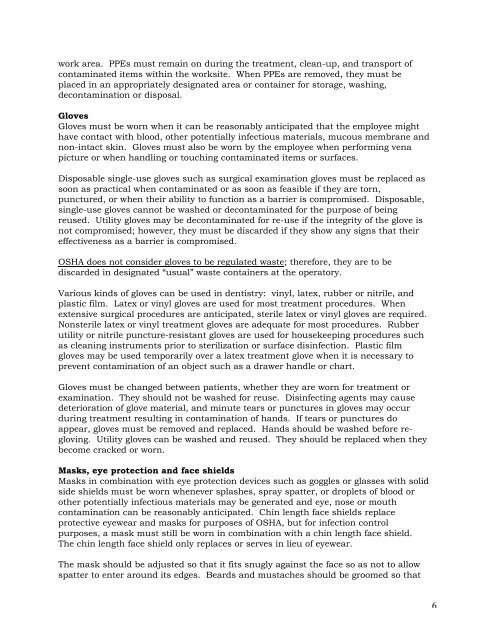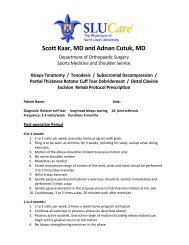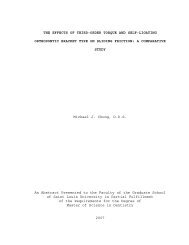Program Manual - Saint Louis University
Program Manual - Saint Louis University
Program Manual - Saint Louis University
Create successful ePaper yourself
Turn your PDF publications into a flip-book with our unique Google optimized e-Paper software.
work area. PPEs must remain on during the treatment, clean-up, and transport of<br />
contaminated items within the worksite. When PPEs are removed, they must be<br />
placed in an appropriately designated area or container for storage, washing,<br />
decontamination or disposal.<br />
Gloves<br />
Gloves must be worn when it can be reasonably anticipated that the employee might<br />
have contact with blood, other potentially infectious materials, mucous membrane and<br />
non-intact skin. Gloves must also be worn by the employee when performing vena<br />
picture or when handling or touching contaminated items or surfaces.<br />
Disposable single-use gloves such as surgical examination gloves must be replaced as<br />
soon as practical when contaminated or as soon as feasible if they are torn,<br />
punctured, or when their ability to function as a barrier is compromised. Disposable,<br />
single-use gloves cannot be washed or decontaminated for the purpose of being<br />
reused. Utility gloves may be decontaminated for re-use if the integrity of the glove is<br />
not compromised; however, they must be discarded if they show any signs that their<br />
effectiveness as a barrier is compromised.<br />
OSHA does not consider gloves to be regulated waste; therefore, they are to be<br />
discarded in designated “usual” waste containers at the operatory.<br />
Various kinds of gloves can be used in dentistry: vinyl, latex, rubber or nitrile, and<br />
plastic film. Latex or vinyl gloves are used for most treatment procedures. When<br />
extensive surgical procedures are anticipated, sterile latex or vinyl gloves are required.<br />
Nonsterile latex or vinyl treatment gloves are adequate for most procedures. Rubber<br />
utility or nitrile puncture-resistant gloves are used for housekeeping procedures such<br />
as cleaning instruments prior to sterilization or surface disinfection. Plastic film<br />
gloves may be used temporarily over a latex treatment glove when it is necessary to<br />
prevent contamination of an object such as a drawer handle or chart.<br />
Gloves must be changed between patients, whether they are worn for treatment or<br />
examination. They should not be washed for reuse. Disinfecting agents may cause<br />
deterioration of glove material, and minute tears or punctures in gloves may occur<br />
during treatment resulting in contamination of hands. If tears or punctures do<br />
appear, gloves must be removed and replaced. Hands should be washed before regloving.<br />
Utility gloves can be washed and reused. They should be replaced when they<br />
become cracked or worn.<br />
Masks, eye protection and face shields<br />
Masks in combination with eye protection devices such as goggles or glasses with solid<br />
side shields must be worn whenever splashes, spray spatter, or droplets of blood or<br />
other potentially infectious materials may be generated and eye, nose or mouth<br />
contamination can be reasonably anticipated. Chin length face shields replace<br />
protective eyewear and masks for purposes of OSHA, but for infection control<br />
purposes, a mask must still be worn in combination with a chin length face shield.<br />
The chin length face shield only replaces or serves in lieu of eyewear.<br />
The mask should be adjusted so that it fits snugly against the face so as not to allow<br />
spatter to enter around its edges. Beards and mustaches should be groomed so that<br />
6

















